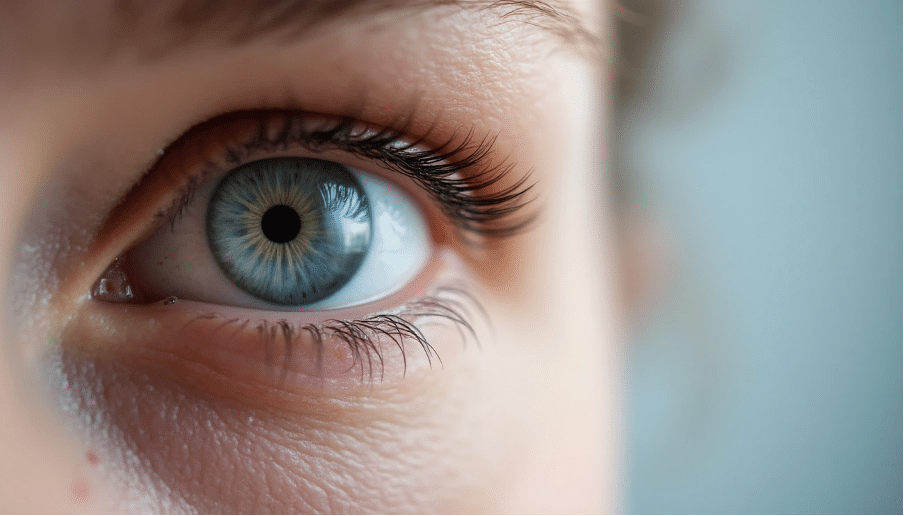Laser eye surgery patients commonly face side effects like blurred vision, dryness, and discomfort during recovery. Your vision may change and symptoms such as grittiness, redness, or light halos could appear for several weeks or months after the procedure.
The side effects might seem worrying, but they’re actually part of the natural healing process. LASIK patients typically notice these symptoms for about 24 hours after surgery. Dry eyes remain one of the most frequent side effects and can last for days or weeks. Recovery duration varies based on your specific procedure and how closely you follow the aftercare guidelines.
Let this piece help you identify normal healing symptoms and potential warning signs that need medical attention. You’ll feel more confident as you heal from your laser eye surgery.

What symptoms are normal after laser eye surgery?
Your eyes will go through several normal healing responses in the days after laser eye surgery. Understanding these common side effects can help you feel more at ease during recovery.
Redness: a common early sign
Right after your procedure, you’ll notice some redness in your eyes. The white parts may look bloodshot for one to two weeks after surgery. On top of that, small blood spots might show up on your eye’s white part where blood vessels broke during the procedure. This temporary redness is just your eye’s natural response to the surgical changes and will fade gradually.
Dry eyes and gritty sensation
Almost all patients—about 95%—get some level of dry eyes right after laser eye surgery. This often feels like grittiness or something stuck in your eye. About 60% of patients still have dry eye symptoms one month after LASIK. These symptoms usually peak in the first months and get better within 6-12 months. Using your prescribed lubricating eye drops regularly will help ease this discomfort.
Blurred vision in the first few days
Your vision will be blurry for the first two to three hours after surgery. Vision usually improves by a lot within 24 hours, but expect some occasional blurriness as your eyes heal. Your vision might take two to three months to fully stabilise. Vision changes are perfectly normal during this healing period.
Light sensitivity and glare
Light sensitivity commonly occurs after your procedure. Many patients see halos, starbursts, or glare around lights, especially when driving at night. These visual issues usually clear up within six months as your cornea heals. Wearing sunglasses outdoors and cutting back on screen time can help reduce discomfort.
Mild discomfort or irritation
Mild discomfort is normal as the anaesthetic drops wear off. Your eyes might burn, itch, or feel irritated. Most patients find this discomfort brief and manageable with over-the-counter pain relievers and lubricating drops. Severe pain is rare—but call your surgeon right away if you have intense pain or worsening symptoms. Note that recovery experiences differ based on your specific procedure. LASIK usually has a faster recovery than PRK or LASEK procedures.
When should you be concerned?
Laser eye surgery recovery goes smoothly for most patients. You should know the difference between normal healing and complications. Here are signs that mean you should contact your eye surgeon right away.
Persistent or worsening redness
Mild redness usually goes away within days after your procedure. Your eyes might stay red or get worse after a few days – that’s when you should call your ophthalmologist. This becomes more significant if you notice other symptoms like light sensitivity or a burning sensation that won’t go away. These symptoms together might show corneal inflammation or incomplete flap healing that needs quick treatment.
Severe or increasing pain
You should not expect severe pain after laser eye surgery – it rarely happens. If you feel intense pain that gets worse, especially with too much tearing, you should see a doctor right away. A flap dislocation causes most cases of severe post-operative pain, which doctors can often fix. Any pain that gets worse instead of better just needs professional help.
Vision that gets worse over time
Your surgeon should know if your vision starts getting worse instead of better. This could mean regression where you start losing your glasses-free vision. A sudden drop in vision quality, especially after weeks or months of good results, might point to problems that need looking into.
Signs of infection: discharge, swelling, fever
Infections after laser eye surgery happen rarely (less than 0.5%) but need quick treatment. Watch out for these warning signs:
- Discharge from your eye
- Too much tearing not from eye drops
- Extreme light sensitivity
- Eye pain or swelling
- Hazy vision
Infections usually show up within 10 days of surgery but can appear up to 8 weeks later. Getting treatment early is vital to protect your vision. Not sure if your symptoms after surgery are normal? The specialists at Precision Vision London can help guide you and give you peace of mind. Book your follow-up consultation today. Note that following your aftercare instructions helps prevent complications. Your follow-up appointments are a great way to discuss any concerns, whatever they might be.
Factors that affect your recovery experience
Your recovery after laser eye surgery depends on several important factors. These elements help you set realistic expectations about your healing process.
Type of procedure: LASIK vs PRK vs LASEK
The surgical technique you choose affects your recovery timeline. LASIK gives you the fastest healing results. Many patients see better eyesight within 24 hours and go back to work within 48 hours. PRK and LASEK take longer to heal because surgeons remove the cornea’s surface layer instead of keeping it as a flap.
Vision stays blurry for about a week after PRK or LASEK. Full recovery can take several weeks to months. These surface procedures disrupt the eye more. Patients often see better vision at first, then a slight drop before steady improvement as healing continues. Patients with thin corneas might find these procedures safer, even though recovery takes longer.
Your age and eye health
Your age affects how fast your eyes heal. Young patients heal better, but this quick healing can sometimes reverse some treatment effects. The cornea’s structure changes with age. Its collagen framework becomes stiffer and less flexible.
Eyes over 40 might not reshape as well after surgery. This leads to less predictable results in older patients. Studies show that about 50% of older patients’ eyes achieve within +0.13 D of spherical equivalent, while younger groups reach 76%.
Pre-existing dry eye or other conditions
Health conditions can change your recovery path. Diabetic patients face unique challenges because their eye surface might not heal well, which increases infection risk. LASIK works better than PRK or LASEK for diabetic patients because it heals faster and causes less inflammation. Dry eyes often get worse right after surgery and might slow down your recovery. Eye conditions like glaucoma need extra attention because LASIK puts temporary pressure on the eye.
How well you follow aftercare instructions
Following your doctor’s instructions helps you recover well. You need to use eye drops correctly, keep water away from your eyes for the first week, and avoid eye makeup for seven days.
Your surgeon needs to check your progress at follow-up appointments to spot any issues early. You might need to wear protective eyewear while sleeping and sunglasses outdoors. Good aftercare reduces complications and helps you get the best vision results.
How to manage symptoms and support healing
Good aftercare helps minimise laser eye surgery side effects and ensures the best results. This guidance will help you direct your recovery smoothly.
Using prescribed eye drops correctly
Your procedure requires antibiotic and anti-inflammatory eye drops four times daily for at least one week. The drops work best when applied five minutes apart. Many specialists suggest the ‘wrist-knuckle’ technique to apply drops correctly: make a fist, pull your lower eyelid down with your knuckles, look up, and squeeze one drop into your lower lid.
Avoiding screens and bright lights
Stay away from screens during the first 24-48 hours after surgery. You can slowly start using screens again with short 5-10 minute sessions. The 20-20-20 rule helps during recovery: look at something 20 feet away for 20 seconds every 20 minutes. Good quality sunglasses protect your eyes from harsh light outdoors.
When to resume driving and work
Someone else must drive you home after surgery. LASIK patients usually return to work within 48 hours, while LASEK patients might need up to seven days. Your surgeon needs to clear you during your first follow-up visit before you start driving again. Swimming should wait for two weeks, and high-impact or contact sports need at least a month’s break.
Tips for reducing dry eye symptoms
Dry eyes affect about 95% of patients right after surgery. Drinking plenty of water helps curb dryness along with prescribed eye drops. A humidifier at home or work adds moisture to the air and provides relief. Omega-3 supplements might help with lasting dryness symptoms.
Follow-up appointments and monitoring
Your first check-up happens the day after surgery. More visits follow at 3-4 weeks, 3 months, and one year. These let your surgeon check your healing progress. These visits play a vital role in addressing concerns and ensuring the best outcomes. Your post-surgery symptoms might worry you. The specialists at Precision Vision London offer expert guidance and peace of mind. Book your follow-up consultation today.
Conclusion
Recovery from laser eye surgery involves a temporary adjustment period. Most patients notice redness, dryness, and blurred vision as their eyes heal naturally. These symptoms peak in the first few days after the procedure and get better over time. While these effects might worry you, they rarely point to serious problems.
Your recovery time depends on several factors. The type of procedure you choose is a vital factor – LASIK patients recover faster than those who get PRK or LASEK. Your age, eye health, and how well you follow aftercare instructions also shape your recovery experience.
The difference between normal healing and warning signs needs your attention. Mild discomfort, vision changes, and sensitivity to light are expected. However, severe pain, declining vision, or infection signs need immediate medical help.
Using prescribed eye drops regularly, protecting your eyes from bright light, and showing up for follow-up appointments will help you heal better. Vision takes two to three months to fully stabilise, but many patients see substantial improvements within 24-48 hours.
Laser eye surgery has an impressive success rate. Most patients achieve excellent vision correction. The recovery period needs patience and careful attention, but the benefits of less reliance on glasses or contacts make it worth the temporary discomfort. If any symptoms worry you during recovery, quick contact with your eye surgeon will address potential problems fast. This lets you enjoy your improved vision with confidence.
Key Takeaways
Understanding what’s normal versus concerning after laser eye surgery helps ensure a smooth recovery and optimal results.
- Redness, dry eyes, and blurred vision are completely normal for days to weeks after laser eye surgery, affecting up to 95% of patients initially.
- Severe pain, worsening vision, or signs of infection (discharge, swelling, fever) require immediate medical attention from your surgeon.
- LASIK offers faster recovery (24-48 hours) compared to PRK or LASEK procedures, which may take several weeks to heal completely.
- Proper aftercare—using prescribed eye drops correctly, avoiding screens initially, and attending follow-ups—significantly impacts your healing success.
- Complete vision stabilisation typically takes 2-3 months, though most patients notice significant improvements within the first 24-48 hours post-surgery.
Recovery experiences vary based on your procedure type, age, existing eye health, and adherence to aftercare instructions. Most symptoms are temporary and resolve naturally as your eyes heal, but don’t hesitate to contact your surgeon if you’re concerned about any unusual or worsening symptoms.
FAQs
Q1. How long does blurred vision typically last after laser eye surgery? Blurred vision is common immediately after laser eye surgery. While significant improvement often occurs within 24-48 hours, complete vision stabilisation can take 2-3 months. Temporary fluctuations in vision quality during this period are normal as your eyes heal.
Q2. Is it normal to experience dry eyes after laser eye surgery? Yes, dry eyes are a very common side effect, affecting up to 95% of patients initially. This sensation usually peaks in the first few months and typically improves within 6-12 months. Using prescribed lubricating eye drops regularly can help manage this discomfort.
Q3. How long does eye redness persist following laser eye surgery? Some redness in the eyes is normal after laser eye surgery. The whites of your eyes may appear bloodshot for one to two weeks post-surgery. Small blood spots might also appear temporarily. This redness is part of the natural healing process and gradually fades.
Q4. When can I resume normal activities like driving and working after laser eye surgery? Most LASIK patients can return to work within 48 hours, while LASEK patients might need up to seven days. You’ll need clearance from your surgeon before resuming driving, typically given at your first follow-up appointment. Swimming should be avoided for two weeks, and high-impact sports for at least a month.
Q5. What symptoms after laser eye surgery should prompt me to contact my surgeon? While mild discomfort is normal, you should contact your surgeon immediately if you experience severe or increasing pain, vision that worsens over time, or signs of infection such as discharge, excessive swelling, or fever. Persistent or worsening redness beyond a few days also warrants attention.
Authors & Reviewer
-
 Olivia: Author
Olivia: AuthorHi, I'm Olivia, a passionate writer specialising in eye care, vision health, and the latest advancements in optometry. I strive to craft informative and engaging articles that help readers make informed decisions about their eye health. With a keen eye for detail and a commitment to delivering accurate, research-backed content, I aim to educate and inspire through every piece I write.
-
 Dr. CT Pillai: Reviewer
Dr. CT Pillai: ReviewerDr. CT Pillai is a globally recognised ophthalmologist with over 30 years of experience, specialising in refractive surgery and general ophthalmology. Renowned for performing over 50,000 successful laser procedures.

